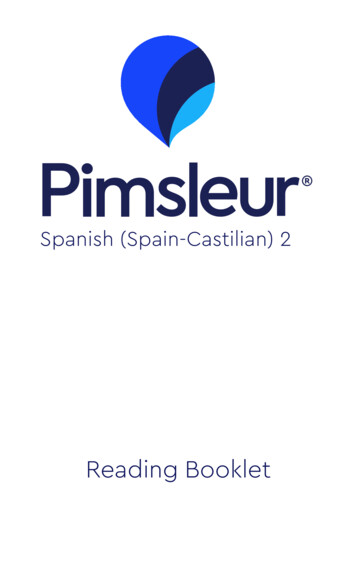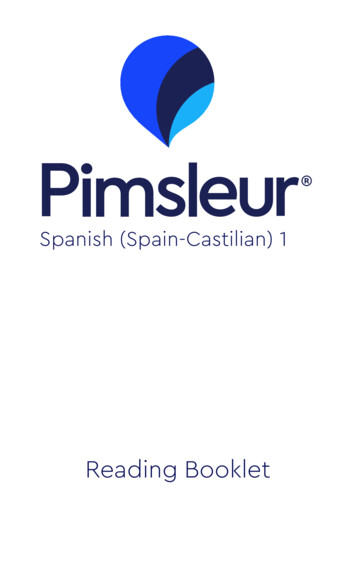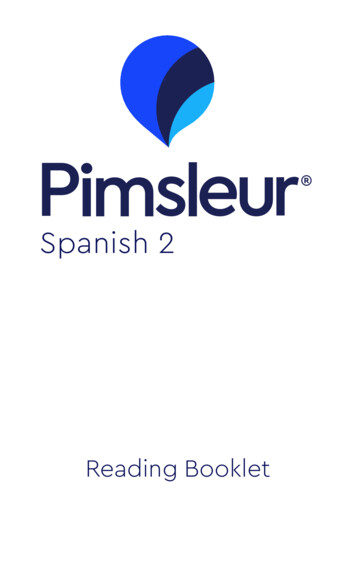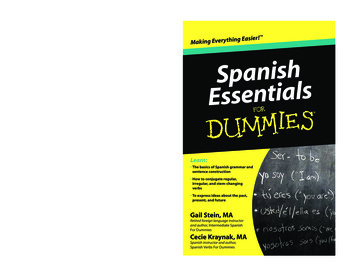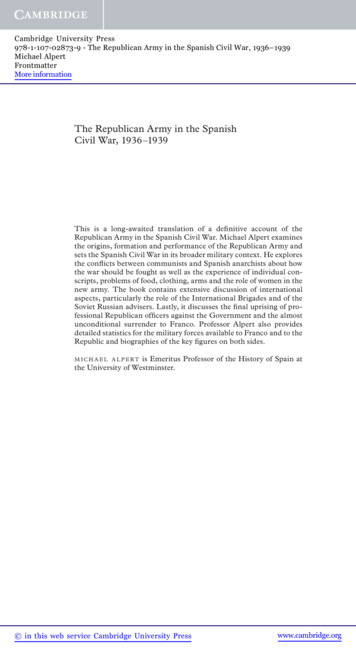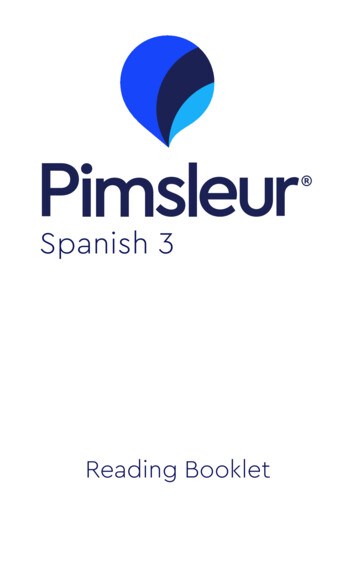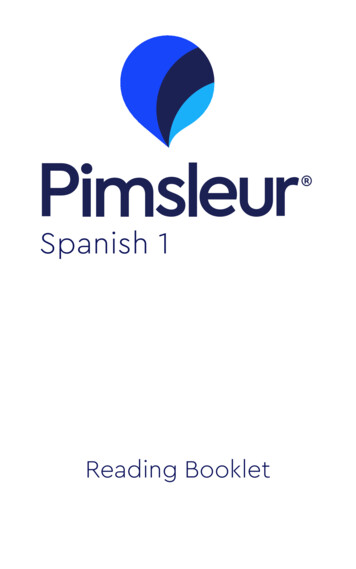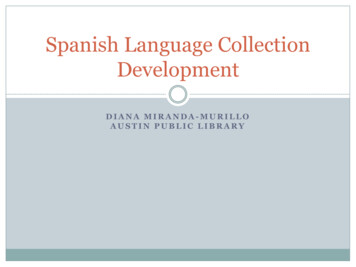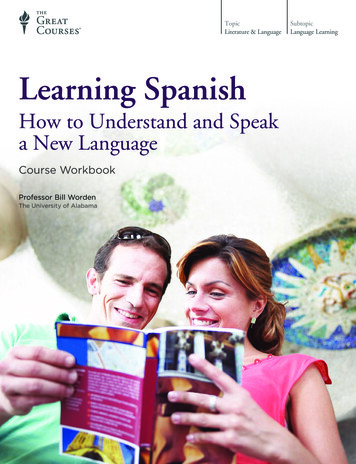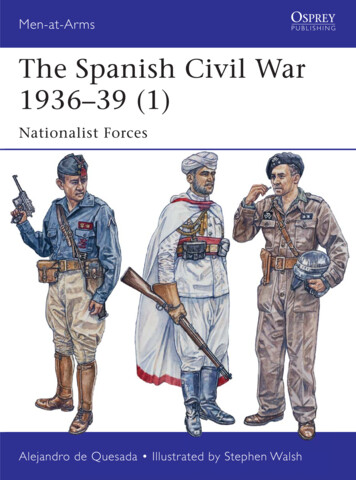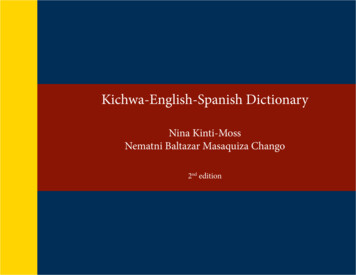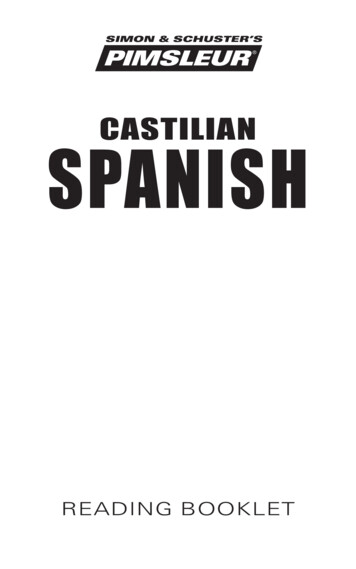
Transcription
SIMON & SCHUSTER’SPIMSLEUR CASTILIANSPANISHreading booklet
Travelers should always check with theirnation's State Department for currentadvisories on local conditions beforetraveling abroad.Graphic Design: Maia Kennedy and ‰ Recorded Program 2012 Simon & Schuster, Inc. Reading Booklet 2012 Simon & Schuster, Inc.Pimsleur is an imprint of Simon & Schuster Audio,a division of Simon & Schuster, Inc. Mfg. in USA.All rights reserved.
ACKNOWLEDGMENTSCASTILIAN SPANISHVoicesEnglish-Speaking Instructor . . . . . . . . . . . . . Ray BrownSpanish-Speaking Instructor . . . . . . . . . . . . Alvaro RuizFemale Spanish Speaker . . . . . . . . . . . . . Marta VelascoMale Spanish Speaker . . . . . . . . . . Ramsés V. MartinezCourse WritersJaime Mauricio Fatás Cabeza Joan SchoellnerEditor & Executive ProducerBeverly D. HeinleProducer & DirectorSarah H. McInnisRecording EngineersPeter S. Turpin Kelly SauxSimon & Schuster Studios, Concord, MAiii
TABLE OF CONTENTSReading LessonsIntroduction . . . . . . . . . . . . . . . . . . . . . . . . . . . . . . . .Castilian Spanish . . . . . . . . . . . . . . . . . . . . . . . . . . . .The Spanish Alphabet . . . . . . . . . . . . . . . . . . . . . . . .Reading Lessons . . . . . . . . . . . . . . . . . . . . . . . . . . . .1456Unit Eleven . . . . . . . . . . . . . . . . . . . . . . . . . . . . . . . .Unit Twelve . . . . . . . . . . . . . . . . . . . . . . . . . . . . . . .Unit Thirteen . . . . . . . . . . . . . . . . . . . . . . . . . . . . . .Unit Fourteen . . . . . . . . . . . . . . . . . . . . . . . . . . . . .Unit Fifteen . . . . . . . . . . . . . . . . . . . . . . . . . . . . . . .Unit Sixteen . . . . . . . . . . . . . . . . . . . . . . . . . . . . . . .Unit Seventeen . . . . . . . . . . . . . . . . . . . . . . . . . . . . .Unit Eighteen . . . . . . . . . . . . . . . . . . . . . . . . . . . . . .Unit Nineteen . . . . . . . . . . . . . . . . . . . . . . . . . . . . . .Unit Twenty . . . . . . . . . . . . . . . . . . . . . . . . . . . . . . . .Unit Twenty-One . . . . . . . . . . . . . . . . . . . . . . . . . . . .Unit Twenty-Two . . . . . . . . . . . . . . . . . . . . . . . . . . .Unit Twenty-Three . . . . . . . . . . . . . . . . . . . . . . . . . .Unit Twenty-Four . . . . . . . . . . . . . . . . . . . . . . . . . . .Unit Twenty-Five . . . . . . . . . . . . . . . . . . . . . . . . . . .Unit Twenty-Six . . . . . . . . . . . . . . . . . . . . . . . . . . . .Unit Twenty-Seven . . . . . . . . . . . . . . . . . . . . . . . . . .Unit Twenty-Eight . . . . . . . . . . . . . . . . . . . . . . . . . . .Unit Twenty-Nine . . . . . . . . . . . . . . . . . . . . . . . . . . .Unit Thirty. . . . . . . . . . . . . . . . . . . . . . . . . . . . . . . . .910111213141516171819202122232425262728v
CASTILIAN SPANISHIntroductionSpanish is the most widely spoken of theRomance languages, which are a Latin branchof the Indo-European language group. Thisbranch includes French, Italian, Portuguese, andRomanian, among others. Spoken primarily inCentral and South America and in Spain --- and bya sizeable and fast-growing population of speakersin the U.S. --- Spanish is the first language ofmore than 350 million people, more than anyother language except Mandarin Chinese. It’sthe official language of twenty-one countries andis one of the six official languages of the UnitedNations. Furthermore, Spanish is a commonsecond language --- the most studied after English,and the third most commonly used on the Internetafter English and Mandarin.The language can be called either “Spanish”or “Castilian.” Both terms are correct, althoughpolitical issues or local custom may dictate whichis used. The name “Castilian” derives from theKingdom of Castile (meaning “Land of Castles”),one of several kingdoms that spread across theIberian peninsula during the Middle Ages. Theterm “Spanish” is a more recent one that firstreferred to Spain as a country and was later appliedto its predominant language as well.
CASTILIAN SPANISHIntroduction (continued)Modern Spanish/Castilian evolved from severaldialects of Latin that were spoken in north-centralIberia during the 8th or 9th century. During thisearly period it was influenced by local languagessuch as Basque. Eventually it spread into thesurrounding area, particularly the south, whereit was further influenced by Arabic. In the 13thcentury, King Alfonso X (known as “Alfonsothe Wise”) was the first king to use Castilianextensively. He also began to standardize it byassembling court scribes and supervising theirwriting --- in Castilian --- on works of history, law,astronomy, and other fields, thereby establishingCastilian as a language of higher learning.In the 15th century, Old Castilian, or OldSpanish, began to evolve into what is nowModern Spanish --- the difference being mainlyone of pronunciation (the devoicing and shiftingof sibilant consonants). Someone who can readModern Spanish can learn to read Old Spanishwith very little difficulty. The difference is muchless stark than between Old English and ModernEnglish.Beginning at the end of the 15th century, theexpansion of the Spanish Empire took Spanishbeyond Spain’s borders --- to Central Europe, the2
CASTILIAN SPANISHIntroduction (continued)Americas, parts of Africa, and several island groupsin the Pacific, among other locations. It becamean important language for government and trade.In Africa, Spanish is now the official language ofonly Equatorial Guinea, and it is no longer spokenby many people in the Pacific. In the Americas,however, the descendants of the original Spaniardscontinued to use Spanish; and in the 19th century,as the colonies overthrew Spanish rule, the newleaders encouraged the population to becomefluent in Spanish in order to strengthen nationalunity. Today it’s the official language of most ofthe South American countries.In addition to Spanish, Spain has three otherofficially recognized languages:Catalan,Galician, and Euskara (Basque). The country alsohosts several regional dialects. In fact, about afourth of the country’s residents use a tongue otherthan Spanish as their first language. Languageidentity and use continue to be pressing politicalissues in parts of the country.3
CASTILIAN SPANISHCastilian SpanishIn the United States, the term “Castilian” or“Castilian Spanish” usually refers to the dialectthat is the official language of Spain, where it’sused in television and radio broadcasts. It isunderstood throughout the country, although thereare marked regional differences.The difference between Castilian Spanishas spoken in Spain and Spanish as spoken in theAmericas (now called Latin American Spanish) isdue to the diminishing contact between Spain andthe Americas over the centuries and to the influenceof local languages in the Americas. These twomain variants of Spanish are mutually intelligible;the difference between them is comparable to thatbetween British English and American English.The main difference is one of pronunciation – mostnotably of the “c” and “z” before an “i” or “e,”which are pronounced as “s” in Central and SouthAmerica and as “th” in Spain. (There is a storythat this “th” pronunciation is because one of theSpanish kings had a lisp. The story is just that – astory. The pronunciation is the result of the naturalevolution of the language.) In addition, there areslight grammatical differences, and certain wordshave regional differences in meanings or alternategenders assigned to them.4
CASTILIAN SPANISHCastilian Spanish (continued)Pimsleur’s “Castilian Spanish” teaches theofficial dialect as spoken by the majority ofSpanish-speakers in Spain.The Spanish AlphabetThe Spanish alphabet once had thirty letters.In addition to the twenty-six letters of the Englishalphabet, “ch,” “ll,” “rr,” and “ñ” were consideredseparate letters. After a revision by the SpanishRoyal Academy in the 1990s, only the “ñ” remains--- for a total of twenty-seven letters. However,some dictionaries and some Latin Americancountries still use the old system. In this system,words beginning with “ch” follow those beginningwith “cz.” Similarly, “ll” follows “lz” and “rr”follows “rz.”Unlike English, Spanish pronunciation of theletters and letter combinations is very consistent.Once you know the basic guidelines, you will beable to read Spanish easily.5
CASTILIAN SPANISHReading LessonsAfter an initial introduction to the spokenlanguage, reading is integrated into the programstarting with Unit Eleven. In these ReadingLessons you will learn to sound out the Spanishalphabet, starting with short words, thenprogressing to longer words, word combinations,and short phrases, increasingly building in lengthuntil you will be reading complete sentences incontext. The Spanish alphabet is systematicallyintroduced and you will learn to associate eachletter with the sounds of Castilian Spanish. Youwill not, at first, be reading for meaning, but ratherfor sound/symbol correlation. Eventually, whenthe sound system is mastered, you will be able tolook at known vocabulary and read for meaning.By the end of the course, you will be reading at thesame level as you are speaking.The reading items in the lessons have beenselected especially to give you practice in theunique Spanish sounds and sound combinations.Your vocabulary acquisition will begin afteryou’ve learned the new, different sound system.You should read aloud, as directed. The processof saying the words out loud will reinforce andenhance your Spanish language acquisition andwill help lodge the sounds of Spanish in your6
CASTILIAN SPANISHReading Lessons (continued)memory. In these Reading Lessons, you will learnto look at the Spanish alphabet with Spanish eyes.There are twenty Spanish Reading Lessons,which start at the end of Unit Eleven. Theselessons are also combined and provided at theend of the course. You may choose to do theReadings along with the units, or you may waituntil you have completed the course and do themall together. Repeat the Reading Lessons as oftenas you wish. Instructions on how to proceed withthe Readings are contained in the audio.7
CASTILIAN SPANISHUnit be14.tenemos15.hablo16.hasta17.hora18.llamo19.Me llamo Carlos.20.Soy de Sevilla.9
CASTILIAN SPANISHUnit a7.por favor8.el papel9.calor10.vamos11.el señor12.baño13.comer14.ellos15.la niña16.comprar17.entender18.avenida19.Hablo un poco de español.20.Habla muy bien, señor.10
CASTILIAN SPANISHUnit Thirteen1.Norteamérica2.¿Es usted de Norteamérica?3.Ud.4.Sí, soy norteamericana.5.Hablo inglés.6.entiendo7.¿Entiende?8.¿Entiende bocadillo14.bañar15.lloro16.No importa.17.¿Cómo está usted, señorita?18.Estamos en Madrid.19.Está bien.20.Adiós.11
CASTILIAN SPANISHUnit Fourteen1.año2.las horas3.el año4.la tarde5.paella6.bueno7.Buenas noches.8.grande9.casa10.la casa grande11.hambre12.hombre13.dos lo19.¿Puede comer pollo?20.¿Por qué no?12
CASTILIAN SPANISHUnit tá7.esta8.aquí9.¿Está allí?10.No está allí, señora.11.habrá12.quedo13.quien14.No tengo dólares.15.¿Dónde está el Hotel La Plata?16.Está a dos calles de aquí.17.¿Es caro?18.Creo que no.19.¿Qué le ha dicho?20.No me ha dicho nada.13
CASTILIAN SPANISHUnit Sixteen1.Buenos días.2.muchacho3.mañana4.No quiero.5.¡Es estupendo!6.gente7.gitano8.un gran gitano9.gerente10.lejos11.Juan12.Jorge13.Tengo un gato.14.la geografía15.gracias16.señor García17.en el centro18.José es mi hermano.19.Vive en Barcelona.20.No sabe conducir.14
CASTILIAN SPANISHUnit Seventeen1.Esa mujer ---2.tiene muchos niños.3.¿Quieres beber algo?4.Hoy es jueves.5.Ese caballero ---6.es mi sobrino.7.Es el número cinco.8.azul9.En el mes de septiembre ---10.empieza el otoño.11.Estoy en la cocina.12.Es un gigante.13.jugar14.No quiero jugar.15.el mes de marzo16.dos cervezas17.la página18.el guiso19.la guerra20.¡Qué horror!15
CASTILIAN SPANISHUnit Eighteen1.correspondencia2.el cielo cubierto3.pague4.llegue5.Llegó a las diez.6.¿Hay tiempo?7.Busco la Plaza Mayor.8.Quiero agua fría.9.Es una zona comercial.10.Cuidado con el perro.11.La señora me llama.12.Necesito alquilar un coche.13.Toca la guitarra.14.enseguida15.Quizá llueva mañana.16.¡Me hace daño!17.¿De dónde es el señor Aguilar?18.Es de Guatemala.19.¿Va a tomar un café?20.No, prefiero un té.16
CASTILIAN SPANISHUnit Nineteen1.buscar2.vino blanco3.vivido / bebido4.Me gusta viajar en barco.5.Los bandidos se van.6.¿Quién va a pagar?7.según el libro8.saco / saque9.la cuenta10.nueve / jueves11.llueve12.el pájaro13.Julio lo dijo.14.¡Qué sonrisa!15.No creo que lleguen.16.Voy a beber tres cervezas ---17.en cuatro minutos.18.¿Conoce a Jorge?19.Sí, le conozco.20.Pero no sé dónde está.17
CASTILIAN SPANISHUnit Twenty1.la ley2.seguir3.No hay nada.4.¿Qué hay allí?5.Hay muchas cosas.6.Vamos a comer ahora.7.Apáguela.8.Apague la luz.9.A las cuatro menos cuarto.10.el número dieciséis11.¡Hola, José!12.Dígame, ¿qué hora es?13.Ahora son las doce.14.No entiendo muy bien.15.¿Dónde está su esposa?16.Mi esposa está en Francia.17.Su nieta vive en París.18.¿De veras?19.Quisiera pedir un vino.20.Gracias por ayudarme.18
CASTILIAN SPANISHUnit Twenty-One1.¿Qué va a beber?2.Voy a tomar un zumo de naranja.3.Puedo beberlo, pero no puedo pagarlo.4.Hoy no tengo dinero.5.Yo tengo muchos euros.6.veinticinco7.treinta y ocho8.cuarenta y nueve9.¿Vais a comprar un recuerdo de España?10.Nosotros no lo sabemos.11.No sabemos qué vamos a comprar.12.Pero queremos comprar algo.13.Porque tenemos euros ---14.--- y tarjeta de crédito.15.¡Qué noche más bella!16.Al día siguiente ---17.--- llegué a Los Ángeles.18.Siga por allí.19.¿Cuánto tiempo para llegar?20.Desafortunadamente, no lo sé.19
CASTILIAN SPANISHUnit Twenty-Two1.Tiene la boca abierta.2.Se acue
4 CASTILIAN SPANISH Castilian Spanish In the United States, the term “Castilian” or “Castilian Spanish” usually refers to the dialect that is the official language of Spain, where it’s used in television and radio broadcasts. It is understood throughout the country, although there are marked regional differences. The difference between Castilian Spanish as spoken in Spain and Spanish .
